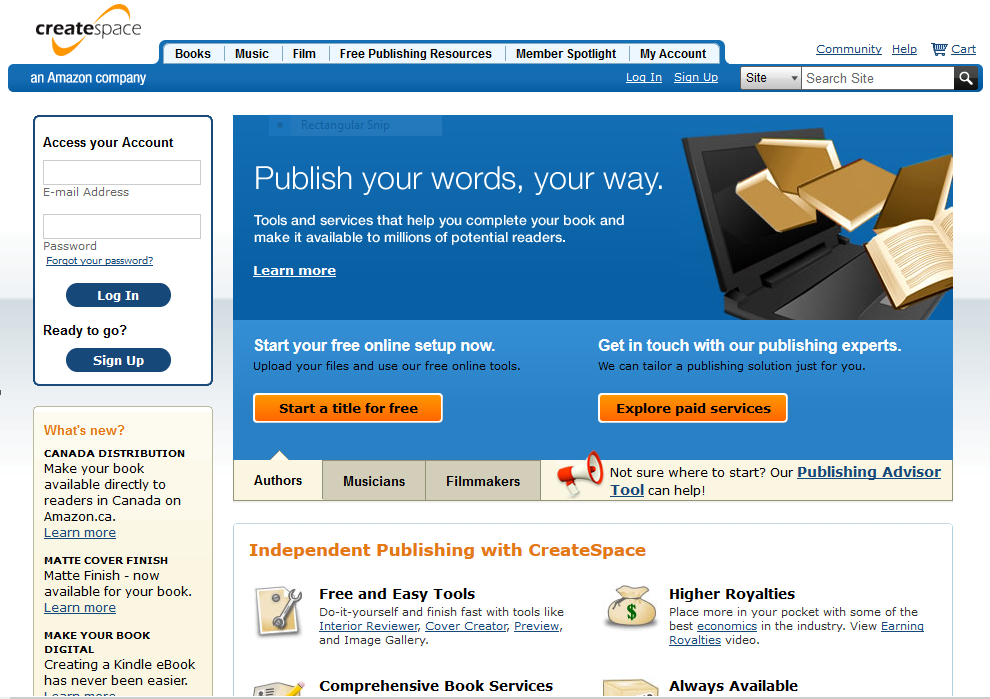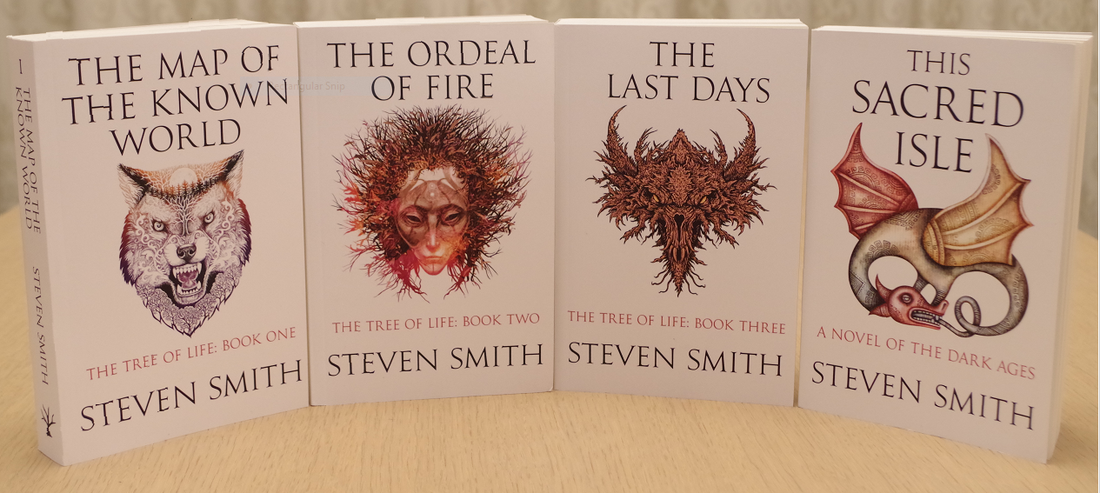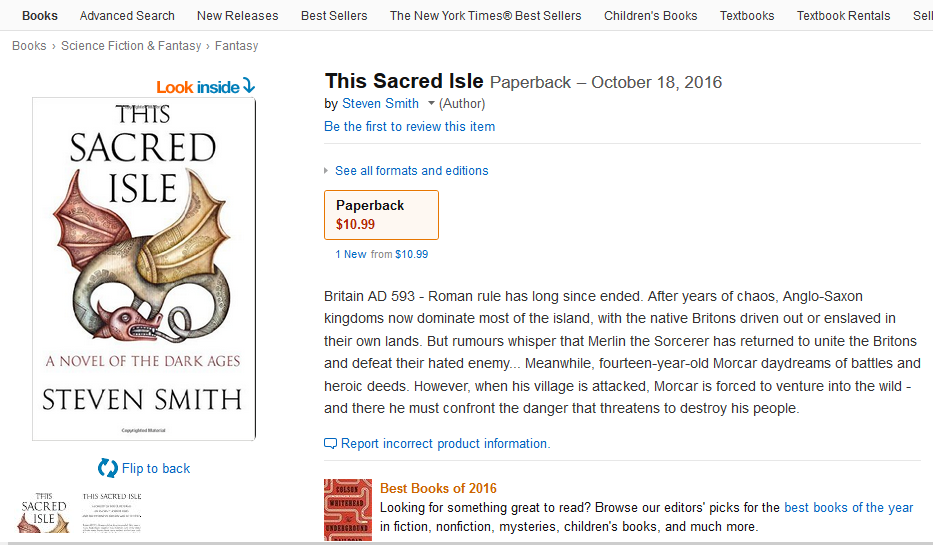|
Many indie authors now predominantly publish their work in e-book format and there is a sound logic to this: it keeps costs down and provides an easier way to reach a wider readership. E-books are wonderful for readers and authors, but as a lover of paperbacks too, I really wanted physical copies of my books to complement the electronic versions. Initially, I did consider a small / medium print run with a local book printing company – I am sure they would have done a good job, but frankly the costs were too high. Therefore, I decided to take the online, Print on Demand (POD) option. A number of companies offer this service, foremost among them CreateSpace, Lulu.com and IngramSpark (and many others). After much research and consideration, I decided to use CreateSpace. The Amazon-owned company have become a major player in indie-publishing but is the service they offer authors a good investment? In this post I am going to describe what it is like for an indie author to use CreateSpace. Before I used CreateSpace I had previously published paperback books through Lulu.com. On the whole, my experience with Lulu.com was positive: the print quality was high, the distribution outlets worked well and the publishing process was relatively straightforward. So, why did I switch? A couple of factors attracted me to CreateSpace and they were both areas I perceived as weaknesses with Lulu.com’s service. The first was cost – in comparison, I found it cheaper to publish paperbacks through CreateSpace. Like all indie authors and publishers I have to keep a close eye on the bottom line, so CreateSpace’s cheaper production costs were a benefit. Admittedly Lulu.com regularly holds offers and special events, which reduce unit costs, but this can be tricky to tie in with publishing schedules. CreateSpace’s shipping costs are a little on the high side (I’m based in the UK) but the overall unit cost is still cheaper than other providers. I wanted to price my latest book (This Sacred Isle) at £7.99, which I felt was in line with similar books in the fantasy genre. The CreateSpace production costs made this possible, while still allowing a small royalty on each copy sold - had I used another POD provider, I estimate I would have had to price my book at £8.99 or higher. The other attraction of CreateSpace over Lulu.com was the ability to print a paperback in my preferred trim size of 5.06 x 7.81 inches (standard, in the UK at least). My earlier books were printed in a 6 x 9 inches and while I know some authors / readers like that format, for me it feels too large for paperbacks and is seldom used by traditional publishers. There was a drawback to using the 5.06 x 7.81 trim size, namely that (with cream paper) it does not qualify for CreateSpace’s expanded distribution. This was disappointing and a little frustrating but I viewed it as a trade-off I was willing to accept. I wanted a paperback that looked and felt right, and I was willing to compromise on distribution to achieve that – of course, others may disagree with my decision! So, I decided to switch to CreateSpace, both for my latest book and for shiny new editions of my Tree of Life fantasy series! Using CreateSpace And I must say I have found CreateSpace publishing relatively pain-free! To create the interior file, you download a Word template for your chosen trim size, and it proved an easy enough task to transfer my story into this format. There are more than ten printing options (trim sizes) for black and white paperbacks (and a similar number for full-colour books) so you should be able to find a size to suit your needs and preferences. For your book’s cover, you can make use of CreateSpace’s free online tool – this looks rather limited but I guess if you’re looking for a simple cover this would be suffice; I doubt it will give you a fully professional appearance though. The other, and I think best, option is to upload your own cover. The submission requirements for doing so are clear, and you can download the CreateSpace template (a format that will match your books’ trim size and number of pages) for you or your cover designer to work from. Once your book’s interior file and cover are ready to go, you simply upload both files to CreateSpace. The files will then be ‘reviewed’ and you should hear back within 24 hours as to whether or not they meet the technical requirements for printing. If you have taken some care and followed the instructions up to this point, you shouldn’t have any problems. After CreateSpace reviews your book files, you will sometimes get the following message: “The cover contains transparency which is flattened during our processing and may result in a slight change in appearance.” Although this looks a little alarming, in my experience, even when I have received this message the proof has printed without any issues at all. So if you do get this message, I wouldn’t worry too much. Once CreateSpace confirms your book meets their technical requirements, you’ll have a print-ready document you can view via an online previewer, which operates like a virtual book. This is a good way to preview your book and spot problems, though you are (correctly) recommended to purchase a printed proof copy for a full edit. Adding key data about your book (title, description, edition number etc.) is simple, as are the processes for pricing and distribution. There is a royalty calculator as well as an online tool to work out how much it will cost you (including shipping) to buy physical copies of your book (for your own distribution). You are handheld through these stages (and you can save and return to them at will), so regardless of your technical competency with computers, you shouldn’t find it too taxing. In addition, there is an active CreateSpace Community, which is an invaluable source of advice and inspiration. Professional services and distribution CreateSpace advertises a number of paid professional services such as editing, formatting and cover design – I cannot comment on these as I sourced such services independently. CreateSpace also offers a Kindle e-book conversion service ($79, with a charge of $139 for a ‘complex’ conversion). Again, I did not use this service, opting instead to create my Kindle e-books separately through KDP, which was simple to achieve. There are two distribution options – standard and expanded – and both are free to join, although as I referred to earlier, only certain books qualify for ‘expanded’. Both standard and expanded are decent options, as even standard makes your book available across the various Amazon platforms as well as the CreateSpace e-store. The final product… So, what is the finished article like? I was very satisfied with the print quality of my books. I believe they stand comparison with industry standard paperbacks. The interior paper feels of a good standard, and the cover colours are clear and vibrant. I did have an issue with one of my proofs – some of the lines in the interior pages were slanted. I queried this with CreateSpace support; they investigated the problem and found it was a printing fault and sent me another proof (which was fine) at no further charge – from a customer perspective, I can’t say fairer than that. The books appeared on Amazon within a few days of completing the publishing process, although the ‘Look inside’ feature took a little longer. If you have a definite ‘release date’ for your book, you might want to publish at least three or four days in advance to avoid the embarrassment of your book not being available for the eager readers who want to buy it! Conclusion
I have found CreateSpace a good solution for my publishing needs. The costs are reasonable, the process is user-friendly and transparent, and their customer support proved responsive and helpful. It is shame I cannot access extended distribution for my chosen trim size – I hope this is something CreateSpace will offer in the future! I plan to use CreateSpace again for future books and would not hesitate to recommend them to indie authors. Of course, others may have different needs, but I think CreateSpace would cover most criteria for paperback indie publishing and at a cost that shouldn’t break your budget! Happy creating… Have you used CreateSpace? How did it work for you? Post a comment and join the conversation.
2 Comments
19/11/2021 08:55:02 am
Using Print-On-Demand services to print books is actually a very good idea. I have learnt a lot about book printing and publishing through your article. Thank you for sharing this amazing article with us.
Reply
Leave a Reply. |
Archives
October 2023
Categories
All
|



 RSS Feed
RSS Feed